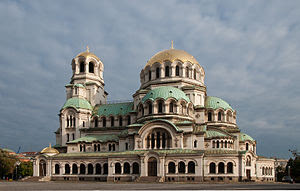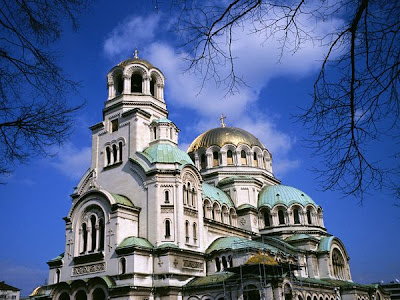The St. Alexander Nevsky Cathedral (Bulgarian: Храм-паметник „Свети Александър Невски“, Hram-pametnik „Sveti Aleksandar Nevski“) is a Bulgarian Orthodox cathedral in Sofia, the capital of Bulgaria. Built in Neo-Byzantine style, it serves as the cathedral church of the Patriarch of Bulgaria and is one of the largest Eastern Orthodox cathedrals in the world, as well as one of Sofia's symbols and primary tourist attractions. The St. Alexander Nevsky Cathedral in Sofia occupies an area of 3,170 square metres (34,100 sq ft) and can hold 10,000 people inside. It is the biggest cathedral located on the Balkan Peninsula.
Architecture
The Alexander Nevsky Cathedral is a cross-domed basilica featuring an emphasized central dome. The cathedral's gold-plated dome is 45 m high (148 ft), with the bell tower reaching 53 metres (174 ft).The temple has 12 bells with total weight of 23 tons, the heaviest weighing 12 tons and the lightest 10 kilograms (22 lb). The interior is decorated with Italian marble in various colours, Brazilian onyx, alabaster, and other luxurious materials. The central dome has the Lord's Prayer inscribed around it, with thin gold letters.
Design and construction
Name changes
The name of the cathedral was briefly changed to the Sts. Cyril and Methodius Cathedral between 1916 and 1920 (since Bulgaria and Russia belonged to opposing alliances in WWI), but then the initial name was restored. The St. Alexander Nevsky Cathedral was proclaimed a monument of culture on 12 September 1924.
Relics
To the left of the altar is a case displaying relics of Alexander Nevsky, given by the Russian Orthodox Church. Although the accompanying Bulgarian-language plaque refers simply to "relics" (мощи), the item on display appears to be a piece of a rib.
Museum and market
There is a museum of Bulgarian icons inside the cathedral crypt, part of the National Art Gallery. The church claims that the museum contains the largest collection of Orthodox icons in Europe.
Nearby locations
The cathedral is adjacent to St. Sofia Church, the church for which the city of Sofia is named. Other notable landmarks in the immediate vicinity of the cathedral are the Monument to the Unknown Soldier, the Bulgarian Academy of Sciences, the National Gallery of Foreign Art, the Bulgarian parliament and a park honoring Ivan Vazov, where one can buy handmade textiles, icons, and antiques in a small flea market.











Niciun comentariu:
Trimiteți un comentariu